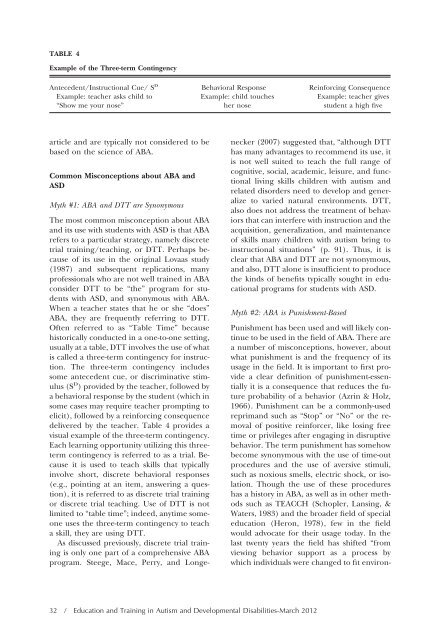Beyond Time Out and Table Time - Division on Autism and ...
Beyond Time Out and Table Time - Division on Autism and ...
Beyond Time Out and Table Time - Division on Autism and ...
Create successful ePaper yourself
Turn your PDF publications into a flip-book with our unique Google optimized e-Paper software.
TABLE 4<br />
Example of the Three-term C<strong>on</strong>tingency<br />
Antecedent/Instructi<strong>on</strong>al Cue/ S D<br />
Example: teacher asks child to<br />
“Show me your nose”<br />
article <str<strong>on</strong>g>and</str<strong>on</strong>g> are typically not c<strong>on</strong>sidered to be<br />
based <strong>on</strong> the science of ABA.<br />
Comm<strong>on</strong> Misc<strong>on</strong>cepti<strong>on</strong>s about ABA <str<strong>on</strong>g>and</str<strong>on</strong>g><br />
ASD<br />
Myth #1: ABA <str<strong>on</strong>g>and</str<strong>on</strong>g> DTT are Syn<strong>on</strong>ymous<br />
The most comm<strong>on</strong> misc<strong>on</strong>cepti<strong>on</strong> about ABA<br />
<str<strong>on</strong>g>and</str<strong>on</strong>g> its use with students with ASD is that ABA<br />
refers to a particular strategy, namely discrete<br />
trial training/teaching, or DTT. Perhaps because<br />
of its use in the original Lovaas study<br />
(1987) <str<strong>on</strong>g>and</str<strong>on</strong>g> subsequent replicati<strong>on</strong>s, many<br />
professi<strong>on</strong>als who are not well trained in ABA<br />
c<strong>on</strong>sider DTT to be “the” program for students<br />
with ASD, <str<strong>on</strong>g>and</str<strong>on</strong>g> syn<strong>on</strong>ymous with ABA.<br />
When a teacher states that he or she “does”<br />
ABA, they are frequently referring to DTT.<br />
Often referred to as “<str<strong>on</strong>g>Table</str<strong>on</strong>g> <str<strong>on</strong>g>Time</str<strong>on</strong>g>” because<br />
historically c<strong>on</strong>ducted in a <strong>on</strong>e-to-<strong>on</strong>e setting,<br />
usually at a table, DTT involves the use of what<br />
is called a three-term c<strong>on</strong>tingency for instructi<strong>on</strong>.<br />
The three-term c<strong>on</strong>tingency includes<br />
some antecedent cue, or discriminative stimulus<br />
(S D ) provided by the teacher, followed by<br />
a behavioral resp<strong>on</strong>se by the student (which in<br />
some cases may require teacher prompting to<br />
elicit), followed by a reinforcing c<strong>on</strong>sequence<br />
delivered by the teacher. <str<strong>on</strong>g>Table</str<strong>on</strong>g> 4 provides a<br />
visual example of the three-term c<strong>on</strong>tingency.<br />
Each learning opportunity utilizing this threeterm<br />
c<strong>on</strong>tingency is referred to as a trial. Because<br />
it is used to teach skills that typically<br />
involve short, discrete behavioral resp<strong>on</strong>ses<br />
(e.g., pointing at an item, answering a questi<strong>on</strong>),<br />
it is referred to as discrete trial training<br />
or discrete trial teaching. Use of DTT is not<br />
limited to “table time”; indeed, anytime some<strong>on</strong>e<br />
uses the three-term c<strong>on</strong>tingency to teach<br />
a skill, they are using DTT.<br />
As discussed previously, discrete trial training<br />
is <strong>on</strong>ly <strong>on</strong>e part of a comprehensive ABA<br />
program. Steege, Mace, Perry, <str<strong>on</strong>g>and</str<strong>on</strong>g> L<strong>on</strong>ge-<br />
Behavioral Resp<strong>on</strong>se<br />
Example: child touches<br />
her nose<br />
necker (2007) suggested that, “although DTT<br />
has many advantages to recommend its use, it<br />
is not well suited to teach the full range of<br />
cognitive, social, academic, leisure, <str<strong>on</strong>g>and</str<strong>on</strong>g> functi<strong>on</strong>al<br />
living skills children with autism <str<strong>on</strong>g>and</str<strong>on</strong>g><br />
related disorders need to develop <str<strong>on</strong>g>and</str<strong>on</strong>g> generalize<br />
to varied natural envir<strong>on</strong>ments. DTT,<br />
also does not address the treatment of behaviors<br />
that can interfere with instructi<strong>on</strong> <str<strong>on</strong>g>and</str<strong>on</strong>g> the<br />
acquisiti<strong>on</strong>, generalizati<strong>on</strong>, <str<strong>on</strong>g>and</str<strong>on</strong>g> maintenance<br />
of skills many children with autism bring to<br />
instructi<strong>on</strong>al situati<strong>on</strong>s” (p. 91). Thus, it is<br />
clear that ABA <str<strong>on</strong>g>and</str<strong>on</strong>g> DTT are not syn<strong>on</strong>ymous,<br />
<str<strong>on</strong>g>and</str<strong>on</strong>g> also, DTT al<strong>on</strong>e is insufficient to produce<br />
the kinds of benefits typically sought in educati<strong>on</strong>al<br />
programs for students with ASD.<br />
Myth #2: ABA is Punishment-Based<br />
Reinforcing C<strong>on</strong>sequence<br />
Example: teacher gives<br />
student a high five<br />
Punishment has been used <str<strong>on</strong>g>and</str<strong>on</strong>g> will likely c<strong>on</strong>tinue<br />
to be used in the field of ABA. There are<br />
a number of misc<strong>on</strong>cepti<strong>on</strong>s, however, about<br />
what punishment is <str<strong>on</strong>g>and</str<strong>on</strong>g> the frequency of its<br />
usage in the field. It is important to first provide<br />
a clear definiti<strong>on</strong> of punishment-essentially<br />
it is a c<strong>on</strong>sequence that reduces the future<br />
probability of a behavior (Azrin & Holz,<br />
1966). Punishment can be a comm<strong>on</strong>ly-used<br />
reprim<str<strong>on</strong>g>and</str<strong>on</strong>g> such as “Stop” or “No” or the removal<br />
of positive reinforcer, like losing free<br />
time or privileges after engaging in disruptive<br />
behavior. The term punishment has somehow<br />
become syn<strong>on</strong>ymous with the use of time-out<br />
procedures <str<strong>on</strong>g>and</str<strong>on</strong>g> the use of aversive stimuli,<br />
such as noxious smells, electric shock, or isolati<strong>on</strong>.<br />
Though the use of these procedures<br />
has a history in ABA, as well as in other methods<br />
such as TEACCH (Schopler, Lansing, &<br />
Waters, 1983) <str<strong>on</strong>g>and</str<strong>on</strong>g> the broader field of special<br />
educati<strong>on</strong> (Her<strong>on</strong>, 1978), few in the field<br />
would advocate for their usage today. In the<br />
last twenty years the field has shifted “from<br />
viewing behavior support as a process by<br />
which individuals were changed to fit envir<strong>on</strong>-<br />
32 / Educati<strong>on</strong> <str<strong>on</strong>g>and</str<strong>on</strong>g> Training in <strong>Autism</strong> <str<strong>on</strong>g>and</str<strong>on</strong>g> Developmental Disabilities-March 2012
















